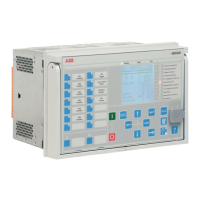levels along the protected line, selectivity requirements, inrush currents and the
thermal and mechanical withstand of the lines to be protected.
Often the above requirements can be best fulfilled using multiple-stage overcurrent
units.
Figure 131
shows an example of this. A brief coordination study has been
carried out between the incoming and outgoing feeders.
The protection scheme is implemented with three-stage numerical overcurrent
protection where the low-set stage PH3LPTOC operates in the IDMT-mode and the
two higher stages, PH3HPTOC and PH3IPTOC, in the DT-mode. Also the thermal
withstand of the line types along the feeder and the maximum expected inrush
currents of the feeders are shown. Faults occurring near the station where the
fault current levels are the highest are cleared rapidly by the instantaneous stage
to minimize the effects of severe short circuit faults. The influence of the inrush
current is taken into consideration by connecting the inrush current detector to the
start value-multiplying input of the instantaneous stage. This way, the start value
is multiplied with a predefined setting during the inrush situation, and nuisance
tripping can be avoided.
MF
MF
OUTGOING
INCOMING
PH3LPTOC
PH3HPTOC
PH3IPTOC
CCBRBRF
INRPHAR
PH3LPTOC
PH3HPTOC
PH3IPTOC
CCBRBRF
MF
OUTGOING
INRPHAR
Line type 2
Line type 1
I
k
max
I
min
I
k
max
I
k
min
I
k
max
I
k
min
9
8
7
Figure 131: Functionality of numerical multiple-stage overcurrent protection
The coordination plan is an effective tool to study the operation of time-selective
operation characteristics. All the points mentioned earlier, required to define
the overcurrent protection parameters, can be expressed simultaneously in a
Protection functions
1MRS757644 H
266 620 series
Technical Manual

